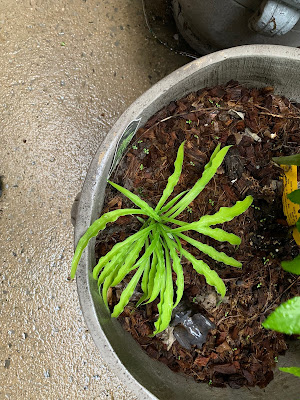Here is Pot # 8. It contains a Sky Pencil Holly, purchased from Forest Farm at Pacifica in 2018, and three Blue Mouse Ears Hostas. The holly is looking a bit grim. It should have glossy green leaves, but they're not very glossy and a bit brownish and some of them are falling off. Surviving.
The hostas, on the other hand, are vigorously thriving.
Pot #9 is a problem pot. I think there's a drainage issue; the soil appears to be compacted and tends to stay wet long after it rains. I've removed the one hosta that actually came up this year, and transplanted it elsewhere. The only other thing in this pot that's not a weed is a willow oak, which self-seeded in another pot last year and which I transplanted here. It seems to be dead.
Here's pot #10. There's an Oregon Fern Japanese Maple, purchased from Forest Farm at Pacifica in 2018, thriving. Three Glacier Ivy plants, purchased at the Union Square Greenmarket in 2018, thriving. And three bare-root hostas, purchased this spring from Michigan Bulb, thriving.
Incidentally, of the eight random hostas I bought from Michigan Bulb this year, four look like they're Blue Mouse Ears, which I already had four of. You might think I'd be disappointed, but you'd be wrong. I'm delighted to have received random hostas I can actually identify, and Blue Mouse Ears is a star of my garden, so the more little blue mice, the merrier!
Pot #11 has a Marvelous Marble Heuchera from last year (thriving like mad), a random hosta from last year's batch of random hostas from WalMart (thriving), and a white swamp oak that self-seeded last year. You can't see the oak (it's by the stake, but hiding behind the hosta), but it's beginning to leaf. Not pictured: the Delta Dawn Heuchera, which should be back by the little white marker, but isn't because it's dead.
Pot #12 has a Columnar European Hornbeam, purchased from Forest Farm at Pacifica in 2018; a Curly Fries hosta, purchased in Connecticut last year during a visit to my friend Liz; and two random hostas from the WalMart batch.
The hornbeam is really leafy this year.
Curly Fries has a very distinctive look for a hosta.
Pot #13 is a Japanese Pieris, not quite as nice as the Japanese Pieris in Pot #1, but definitely
surviving. Those reddish leaves up top are supposed to look that way; the brownish leaves lower down, not so much.
Pot #14: a boxwood (purchased from Brighter Blooms in 2018) and three hostas. Boxwood: thriving.
Mighty Mouse hosta (2018, Acer Farms, Connecticut): thriving.
Rainforest Sunrise hosta (2018, Van Wilgen's, Connecticut): thriving. Possibly needs to be transplanted to a pot with more room.
Random bare-root hosta from Michigan Bulb: this one's a tiny little thing. We'll call it "surviving" for now.
Pot #14A: an Italian maple tree that arrived as a stowaway last year with a hosta I purchased. It's beginning to leaf, so I'm going to call it "thriving."
Pot #14B: the Empress Wu hosta. When fully grown, Empress Wu is one of the largest-leafed hostas around. Like, leaves 25 to 28 inches across! Mine is still a baby. Might need a bigger pot next year.
More to come, later in the week or this weekend. It's hard to believe I now have so many pots that I have to do this in multiple installments.
















No comments:
Post a Comment